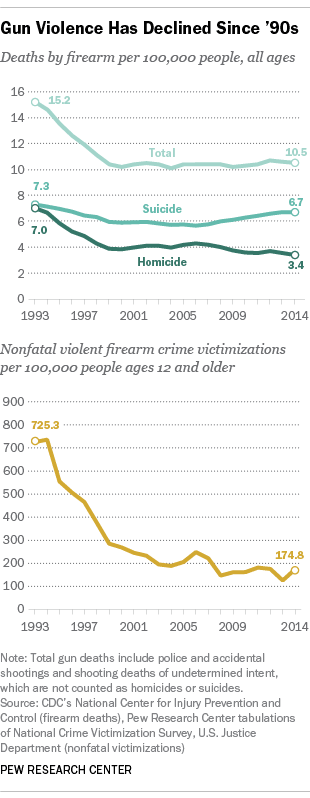
Several mass shootings in recent months have brought renewed attention to the issue of gun violence in America, and President Obama has again called for Congress to change the nation’s gun laws.
But the increased spotlight on guns does not reflect the overall gun violence trend in the country. Although most Americans think the number of gun crimes has risen, the U.S. gun homicide rate has actually stabilized somewhat in recent years, according to a Pew Research Center analysis of death certificate data collected by the Centers for Disease Control and Prevention.
Between 1993 and 2000, the gun homicide rate dropped by nearly half, from 7.0 homicides to 3.8 homicides per 100,000 people. Since then, the gun homicide rate has remained relatively flat. From 2009 to 2014, the most recent year data are available, the number of gun homicides has hovered around 11,000 and 12,000 per year.
By contrast, a significantly higher – and growing – number of gun deaths were by suicide than by homicide, and this has been true throughout the past two decades. For example, while the gun suicide rate has declined overall since 1993, in recent years it has risen, from 6.3 per 100,000 people in 2010 to 6.7 in 2014.
The nation’s overall gun death rate has declined 31% since 1993. This total includes homicides and suicides, in addition to a smaller number of fatal police shootings, accidental shooting deaths and those of undetermined intent. For example, in 2014 there were 464 fatal police shootings, up from 333 in 2009. (Government data on fatal police shootings are also collected and reported by the FBI, though the agency acknowledges there are discrepancies between federal and local law enforcement counts.)
The rate of nonfatal gun victimizations declined in a similar way to the gun death rate, with a large drop in the 1990s – 63% between 1993 and 2000. The decline since then has been more uneven. In 2014, there were 174.8 nonfatal violent gun victimizations per 100,000 people ages 12 and older.
Despite these trends, most U.S. adults think gun crimes have increased. In our 2013 survey, more than half (56%) of Americans said the number of gun crimes had gone up compared with 20 years ago. Another 26% said the number of gun crimes had remained the same, and just 12% said gun crimes had declined.
The public has been divided on the issue of gun ownership in recent years. In our July survey, 50% said it is more important to control gun ownership and 47% said it is more important to protect the right of Americans to own guns. Support for controlling gun ownership has declined; throughout the 1990s and early 2000s, a majority of Americans said it was more important to control gun ownership.
The July survey also found that Americans strongly support a variety of specific gun control measures, including expanded background checks (85%), laws to prevent people with mental illness from purchasing guns (79%) and creation of a federal database to track all gun sales (70%). A smaller majority (57%) support a ban on assault-style weapons.
Note: This post was updated on Jan. 5, 2016, to reflect the latest 2014 data.
